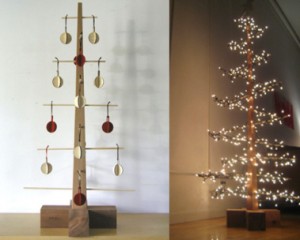- About Us
- Our Work
- Tree Info
- Get Involved
- Blog
- Support Us
Five or ten years ago, some green-conscious consumers felt confident that an artificial Christmas tree was a better alternative to cutting down a live tree.
Today, the prevailing wisdom suggests that artificial trees produced with harmful PVC plastics and lead have a bigger carbon footprint than a cut tree. At the same time, purchasing a sustainably-farmed Christmas tree involves decisions similar to buying an apple (organic versus pesticides, locally grown versus Oregon grown, biodiverse versus monoculture). For others, native versus non-native species is an important consideration in terms of the impact on sustainable habitats.
 As you decide what’s right for you, consider these options:
As you decide what’s right for you, consider these options:
Pros: A live tree is the most sustainable option if you want a fresh tree.
Cons: Most live trees can only survive indoors for 7-10 days before they begin to suffer. Not all live tree species are appropriate for our climate. Planting and caring for your tree after the holidays requires skill and commitment beyond digging a hole in the ground: is the site and soil appropriate for your tree? Do you have the knowledge to plant a tree to maximize its health? Are you committed and prepared to care for your young tree? Check the Canopy Tree Library for species suitability.
Rent a tree: Some local organizations, such as Our City Forest, enable residents to rent a live tree for up to one month. After the holidays, the organization takes the tree back and ensures that it is planted in the community.
Pros: While Christmas trees are being grown, they contribute to green space and digest carbon. After the holiday, recycling options such as mulching are also beneficial to the environment.
Cons: Cut trees are often grown with harmful chemicals. The availability of sustainably-farmed trees (organic, local, bio diverse) is limited.
Pros: If used for a number of years (ranging from six to twenty), conventional artificial trees can equate to a cut Christmas tree’s environmental impact.
Cons: Ninety percent of conventional artificial trees are produced in China with PVC chemicals and lead and will not decompose in the landfill.
Alternative eco-friendly Christmas trees are beginning to emerge on the market. Options include cardboard trees, plywood trees and creative do-it-yourself projects. Here are some fun examples. While the eco-chic Christmas trees on the market may intrigue you, consider the carbon footprint before you whip out your credit card.
Many municipalities and local businesses offer options for recycling your Christmas tree. Check with your City or County, or search for a recycling solution in your area.
Caring for the earth and being conscious of your consumption is worthy work. While one person may decide to forgo a tree and start a new tradition, another person may decide to serve a sustainably-farmed holiday meal…..or perhaps give a loved one a Canopy Tree Gift!